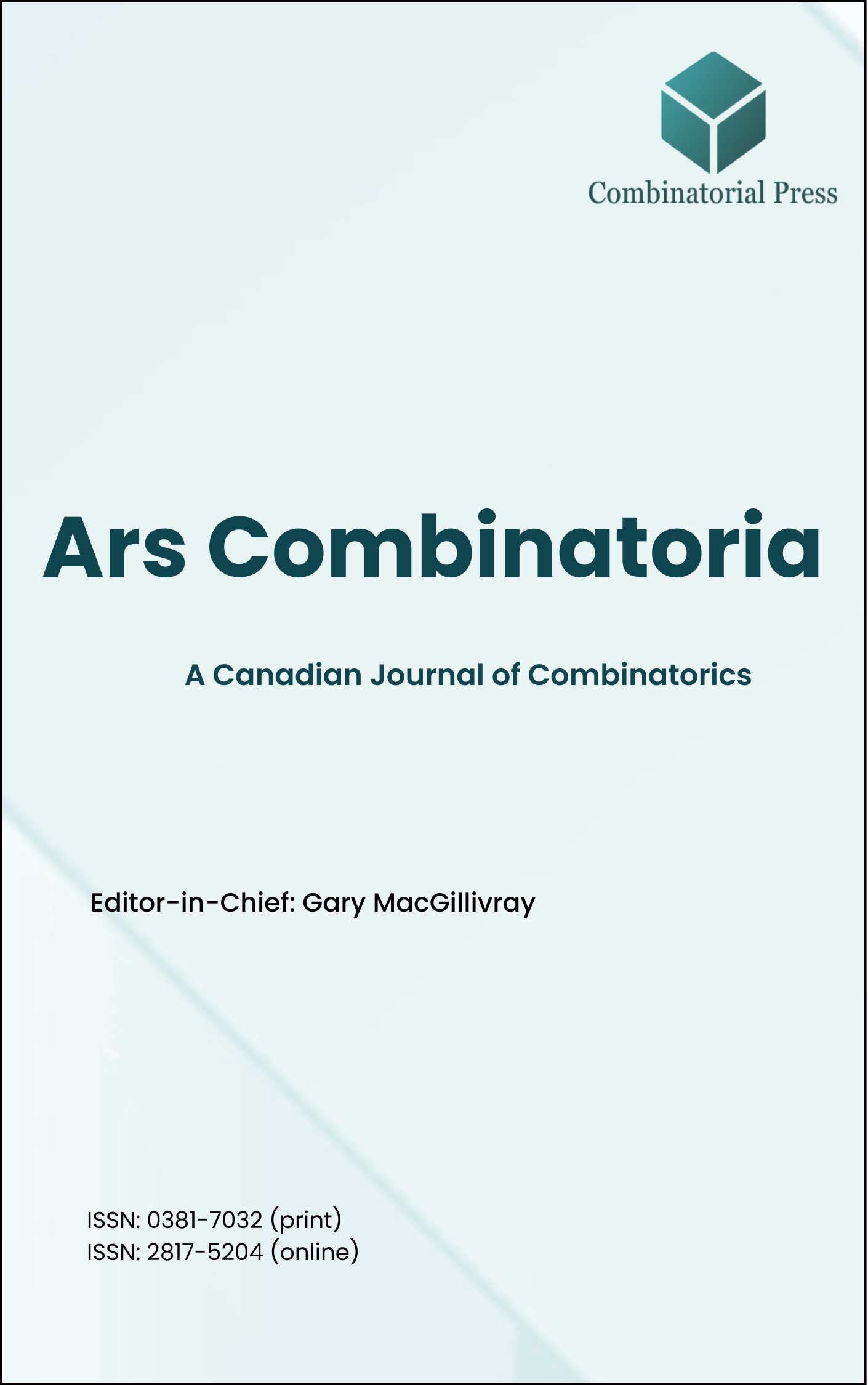
Ars Combinatoria
ISSN 0381-7032 (print), 2817-5204 (online)
Ars Combinatoria is the oldest Canadian Journal of Combinatorics, established in 1976. The journal is dedicated to advancing the field of combinatorial mathematics through the publication of high-quality research papers. From 2024 onward, it publishes four volumes per year in March, June, September and December. Ars Combinatoria has gained recognition and visibility in the academic community and is indexed in renowned databases such as MathSciNet, Zentralblatt, and Scopus. The Scope of the journal includes Graph theory, Design theory, Extremal combinatorics, Enumeration, Algebraic combinatorics, Combinatorial optimization, Ramsey theory, Automorphism groups, Coding theory, Finite geometries, Chemical graph theory but not limited.
Information Menu
- Research article
- Full Text
- Ars Combinatoria
- Volume 098
- Pages: 3-6
- Published: 31/01/2011
The \(Problème \;des \;Ménages\) \((Married \;Couples \;Problem)\), introduced by E. Lucas in 1891, is a classical problem that asks for the number of ways to arrange \(n\) couples around a circular table, such that husbands and wives are in alternate places and no couple is seated together. In this paper, we present a new version of the Menage Problem that carries constraints consistent with Muslim culture.
- Research article
- Full Text
- Ars Combinatoria
- Volume 098
- Pages: 7-14
- Published: 31/01/2011
Let \(G\) be a connected simple graph with girth \(g\) and minimal degree \(\delta \geq 3\). If \(G\) is not up-embeddable, then, when \(G\) is 1-edge connected,
\[\gamma_M(G) \geq \frac{D_1(\delta,g)-2}{2D_1(\delta,g)-1}\beta(G)+ \frac{D_1(\delta,g)+1}{2D_1(\delta,g)-1}.\]
When \(G\) is \(k\)(\(k = 2, 3\))-edge connected ,
\[\gamma_M(G) \geq \frac{D_k(\delta,g)-1}{2D_k(\delta,g)}\beta(G)+ \frac{D_k(\delta,g)+1}{2D_k(\delta,g)}.\]
The functions \(D_k(\delta, g)\) (\(k = 1, 2, 3\)) are increasing functions on \(\delta\) and \(g\).
- Research article
- Full Text
- Ars Combinatoria
- Volume 098
- Pages: 25-32
- Published: 31/01/2011
In this paper, the authors discuss the values of a class of generalized Euler numbers and generalized Bernoulli numbers at rational points.
- Research article
- Full Text
- Ars Combinatoria
- Volume 098
- Pages: 33-61
- Published: 31/01/2011
For two vertices \(u\) and \(v\) in a graph \(G = (V,E)\), the detour distance \(D(u,v)\) is the length of a longest \(u-v\) path in \(G\). A \(u-v\) path of length \(D(u,v)\) is called a \(u-v\) detour. A set \(S \subseteq V\) is called a weak edge detour set if every edge in \(G\) has both its ends in \(S\) or it lies on a detour joining a pair of vertices of \(S\). The weak edge detour number \(dn_w(G)\) of \(G\) is the minimum order of its weak edge detour sets and any weak edge detour set of order \(dn_w(G)\) is a weak edge detour basis of \(G\). Certain general properties of these concepts are studied. The weak edge detour numbers of certain classes of graphs are determined. Its relationship with the detour diameter is discussed and it is proved that for each triple \(D, k, p\) of integers with \(8 \leq k \leq p-D+1\) and \(D \geq 3\) there is a connected graph \(G\) of order \(p\) with detour diameter \(D\) and \(dn_w(G) = k\). It is also proved that for any three positive integers \(a, b, k\) with \(k \geq 3\) and \(a \leq b \leq 2a\), there is a connected graph \(G\) with detour radius \(a\), detour diameter \(b\) and \(dn_w(G) = k\). Graphs \(G\) with detour diameter \(D \leq 4\) are characterized for \(dn_w(G) = p-1\) and \(dn_w^+(G) = p-2\) and trees with these numbers are characterized. A weak edge detour set \(S\), no proper subset of which is a weak edge detour set, is a minimal weak edge detour set. The upper weak edge detour number \(dn_w^+(G)\) of a graph \(G\) is the maximum cardinality of a minimal weak edge detour set of \(G\). It is shown that for every pair \(a, b\) of integers with \(2 \leq a \leq b\), there is a connected graph \(G\) with \(dn_w(G) = a\) and \(dn_w^+(G) = b\).
- Research article
- Full Text
- Ars Combinatoria
- Volume 098
- Pages: 63-71
- Published: 31/01/2011
The vertex Padmakar-Ivan \((PI_v)\) index of a graph \(G\) is defined as the summation of the sums of \([m_{eu}(e|G) + m_{eu}(e|G)]\) over all edges \(e = uv\) of a connected graph \(G\), where \(m_{eu}(e|G)\) is the number of vertices of \(G\) lying closer to \(u\) than to \(v\), and \(m_{eu}(e|G)\) is the number of vertices of \(G\) lying closer to \(v\) than to \(u\). In this paper, we give the explicit expressions of the vertex PI indices of some sums of graphs.
- Research article
- Full Text
- Ars Combinatoria
- Volume 101
- Pages: 45-63
- Published: 31/07/2011
A graph \(G\) is called \(H\)-equicoverable if every minimal \(H\)-covering in \(G\) is also a minimum \(H\)-covering in \(G\). In this paper, we give the characterization of connected \(M_2\)-equicoverable graphs with circumference at most \(5\).
- Research article
- Full Text
- Ars Combinatoria
- Volume 101
- Pages: 27-32
- Published: 31/07/2011
In this paper, we investigate the existence of \(2\)-\((v,8,1)\) designs admitting a block-transitive automorphism group \(G \leq \mathrm{ATL}(1,q)\). Using Weil’s theorem on character sums, the following theorem is proved:If a prime power \(q\) is large enough and \(q \equiv 57 \pmod{112}\), then there is always a \(2-(v,8,1)\) design which has a block-transitive, but non flag-transitive automorphism group \(G.\)
- Research article
- Full Text
- Ars Combinatoria
- Volume 097-A
- Pages: 509-529
- Published: 31/10/2010
In this paper, we show that the independence polynomial \(I(G^*; x)\) of \(G^*\) is unimodal for any graph \(G^*\) whose skeleton \(G\) has stability number \(\alpha(G) \leq 8\). In addition, we show that the independence polynomial of \(K^*_{2,n}\) is log-concave with a unique mode.
- Research article
- Full Text
- Ars Combinatoria
- Volume 097-A
- Pages: 499-508
- Published: 31/10/2010
Let \(G = (V,E)\) be a graph. A set \(S \subseteq V\) is a dominating set of \(G\) if every vertex not in \(S\) is adjacent to some vertex in \(S\). The domination number of \(G\), denoted by \(\gamma(G)\), is the minimum cardinality of a dominating set of \(G\). A set \(S \subseteq V\) is a total dominating set of \(G\) if every vertex of \(V\) is adjacent to some vertex in \(S\). The total domination number of \(G\), denoted by \(\gamma_t(G)\), is the minimum cardinality of a total dominating set of \(G\). In this paper, we provide a constructive characterization of those trees with equal domination and total domination numbers.
- Research article
- Full Text
- Ars Combinatoria
- Volume 097-A
- Pages: 485-497
- Published: 31/10/2010
We consider a variation of a classical Turán-type extremal problem due to Bollobás \([2,p. 398, no. 13]\) as follows: determine the smallest even integer \(\sigma(C^k,n)\) such that every graphic sequence \(\pi = (d_1,d_2,\ldots,d_n)\) with term sum \(\sigma(\pi) = d_1 + d_2 + \cdots + d_n \geq \sigma(C^k,n)\) has a realization \(G\) containing a cycle with \(k\) chords incident to a vertex on the cycle. Moreover, we also consider a variation of a classical Turán-type extremal result due to Faudree and Schelp \([7]\) as follows: determine the smallest even integer \(\sigma(P_\ell,n)\) such that every graphic sequence \(\pi = (d_1,d_2,\ldots,d_n)\) with \(\sigma(\pi) \geq \sigma(P_\ell,n)\) has a realization \(G\) containing \(P_\ell\) as a subgraph, where \(P_\ell\) is the path of length 2. In this paper, we determine the values of \(\sigma(P_\ell,n)\) for \(n \geq \ell+1\) and the values of \(\sigma(C^k,n)\) for \(n \geq (k+3)(2k+5)\).





